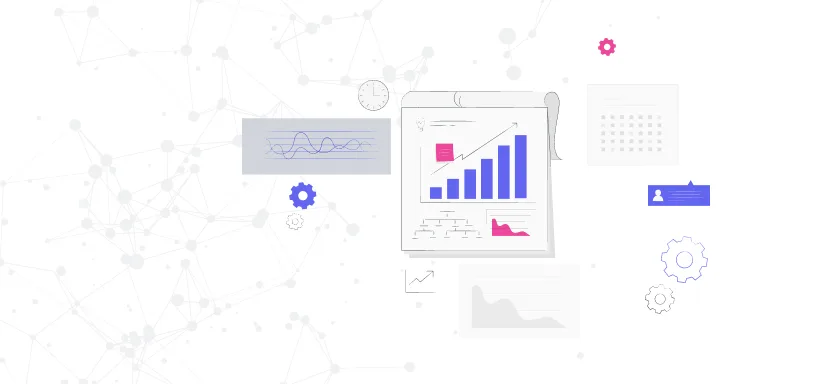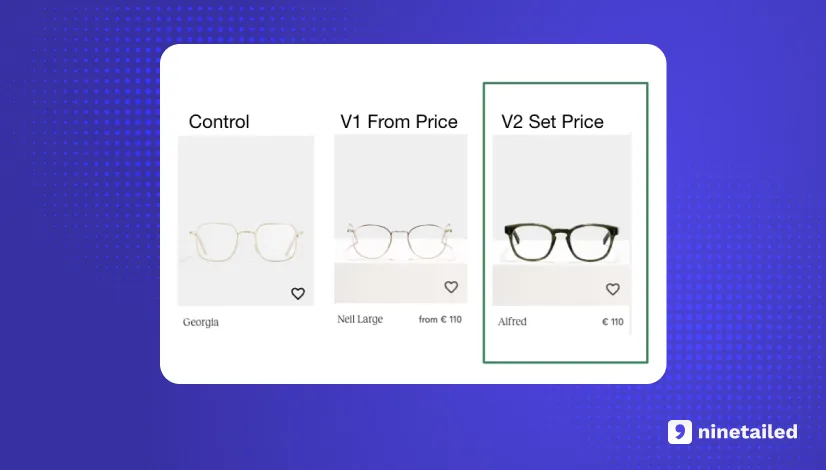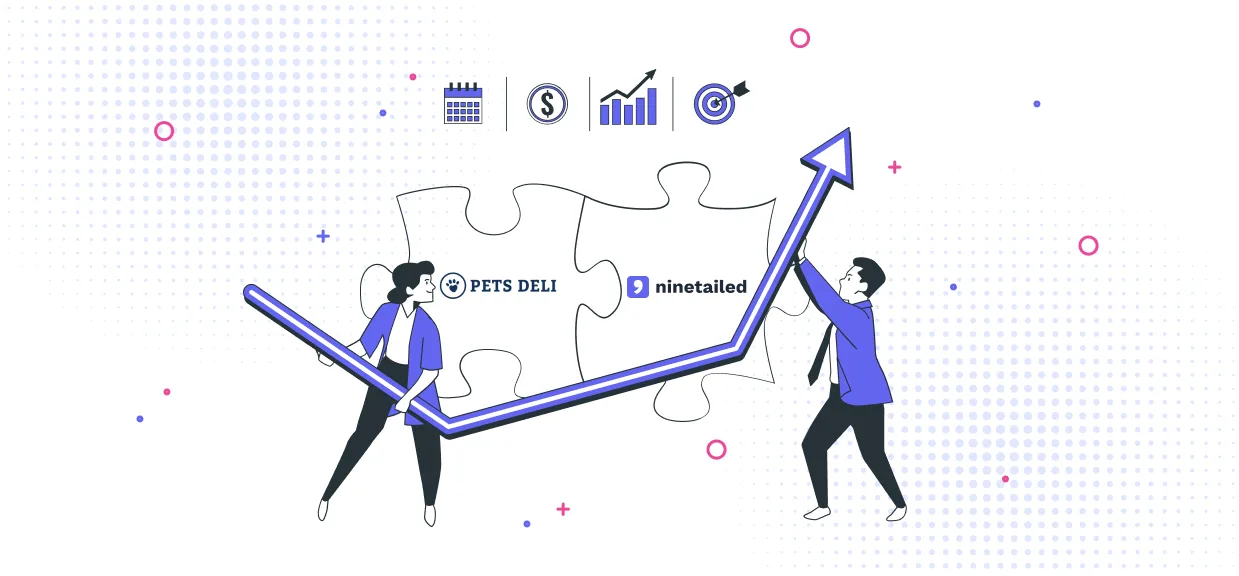- Experimentation,
- Commerce,
- Personalization,
- Growth
E-commerce Conversion Rate Optimization with Real-Life Personalization and Experimentation Examples


In the fast-paced world of e-commerce, it's not enough to simply have an online store.
With millions of options available to consumers, businesses need to stand out and provide a unique and personalized experience to their customers. This is where e-commerce conversion rate optimization (CRO) comes in.
But what exactly is e-commerce CRO?
In simple terms, it refers to the process of improving the percentage of website visitors who take a desired action, such as making a purchase or filling out a form. This is achieved through various tactics, such as:
optimizing website design
improving website speed
implementing personalized marketing strategies
The importance of e-commerce CRO cannot be overstated. A high conversion rate means more sales and revenue, which is the ultimate goal of any e-commerce business.
By optimizing the customer journey and creating a seamless shopping experience, businesses can increase customer loyalty and encourage repeat purchases. In addition, e-commerce CRO allows businesses to gather valuable data about their customer's behavior and preferences, which can inform future marketing and product strategies.
In this blog post, we'll explore real-life examples of e-commerce CRO through personalization and experimentation. We'll discuss how businesses have successfully implemented these tactics to boost their conversion rates and drive sales.
So, whether you're just starting out in e-commerce or looking to take your business to the next level, read on to learn how e-commerce CRO can benefit your business.
Why Personalization and A/B Testing Matters for E-commerce Conversion Rate Optimization?
Personalization and A/B testing are two key tactics in e-commerce conversion rate optimization that can have a significant impact on a business's bottom line.
Firstly, personalization involves tailoring the shopping experience to each individual customer based on their preferences, behavior, and past purchases. By providing a personalized experience, businesses can increase customer satisfaction and loyalty, ultimately leading to higher conversion rates and sales.
According to recent data from Accenture, 91 percent of customers are more willing to buy from brands that deliver relevant offers and suggestions to them.
Personalization can take many forms, such as personalized product recommendations or personalized email campaigns. For example, a clothing retailer could use a customer's past purchase history to suggest similar items they might be interested in. Or, an e-commerce business could send personalized emails to customers with abandoned shopping carts, offering a discount or other incentive to complete their purchase.
By providing personalized experiences,
businesses can build stronger relationships with their customers
increase the likelihood of repeat purchases and loyalty
create a better digital customer experience
ultimately, businesses can drive more sales with higher conversion rates
Secondly, A/B testing involves testing two versions of a website or marketing campaign to see which performs better. By testing different variations, businesses can identify the most effective elements and optimize their conversion rates. For example, an e-commerce business could test two different versions of its website's homepage to see which one leads to more purchases.
A/B testing can help businesses make data-driven decisions and improve their marketing and website design strategies.
By identifying the most effective elements, businesses can make targeted improvements that lead to higher conversion rates and sales. In addition, A/B testing can provide valuable insights into customer behavior and preferences, which can inform future marketing and product strategies.
Overall, personalization and A/B testing are two powerful tactics in e-commerce conversion rate optimization that can help businesses stand out in a crowded marketplace.
By providing personalized experiences and making data-driven decisions, businesses can increase customer satisfaction, loyalty, and, ultimately, their bottom line.
Conversion Rate Optimization 101
Before exploring examples of personalization and A/B testing, let's briefly review the fundamentals of conversion rate optimization:
How Is Conversion Rate Calculated?

The conversion rate is calculated by dividing the number of conversions (such as purchases or form completions) by the total number of website visitors and multiplying by 100 to get a percentage.
For example, if 1000 people visit a website and 50 of them make a purchase, the conversion rate would be 5%.
What Are the Typical Conversion Events for E-commerce?
Typical conversion events for e-commerce include purchases, form completions, account creations, and email signups:
Purchases: The most common conversion event for e-commerce is completing a purchase. This could be a one-time purchase of a product or service, or a subscription to a recurring service.
Form Completions: In some cases, e-commerce businesses may require customers to fill out a form in order to complete a purchase or request more information. Form completions can be a valuable conversion event for businesses, as they provide additional data about the customer and their preferences.
Account Creations: Some e-commerce businesses require customers to create an account in order to complete a purchase. This can be a valuable conversion event, as it allows businesses to gather additional data about the customer and their preferences, and can encourage repeat purchases.
Email Signups: E-commerce businesses may also encourage customers to sign up for their email list in order to receive promotions, discounts, or other offers. Email signups can be a valuable conversion event, as they provide a way for businesses to stay in touch with customers and encourage repeat purchases.
Or any other conversion event that your company finds useful.
What Is a Good E-commerce Conversion Rate?
A good e-commerce conversion rate varies depending on the industry and other factors but generally falls between 2% and 5%.
However, it's important to note that what constitutes a "good" conversion rate can also depend on the specific goals of the business.
The ultimate goal of any e-commerce business is to maximize revenue, so a conversion rate that leads to increased sales and revenue is generally considered good.
Real-Life Examples of Personalization in E-commerce Conversion Rate Optimization
How Ruggable Increased Its CTRs 7x
Ruggable is a game-changing interior brand (rooted in e-commerce) that is transforming the way people think about home decor.
By integrating Ninetailed with Contentful, Ruggable has been able to achieve great success in personalization. From quickly creating different audiences to optimizing customer experience without ever leaving the Contentful interface, they were able to develop and deploy campaigns that met their goals rapidly.
Furthermore, by leveraging the Ninetailed, they were able to bring their ideas to life quickly and effectively.
However, the biggest success Ruggable saw was coming from showing different hero banners to different audiences that landed on the website through a particular ad.
7x higher the click-through rate!
Taejae from Special Projects at Ruggable explains this massive uplift as “Let's say an ad about Ruggable being pet friendly, and then you run into a home page banner that has a dog picture in it as opposed to something completely irrelevant. Click-through rates were close to seven or eight times the original.”
How Pets Deli Increased Its Conversions by 51%
One of the market leaders in the European D2C (direct-to-consumer) pet food market, Pets Deli is a purveyor of high-quality food and supplies for both feline and canine companions.
For Black Friday, the company saw its online conversion rates increase by 51% compared to the same day the previous year.
Pets Deli identified different types of customers, and each segment was offered a unique set of prices and promotions that appealed to their specific needs. This approach proved to be immensely successful, as the company was able to increase its conversions.
To promote personalized pricing strategies, Pets Deli used personalized content for each customer segment. When a customer landed on the website, they saw personalized content promoting personalized pricing in real-time — thanks to the unified customer profiles and high-performance edge API for real-time delivery.
Since the launch of its personalization campaign, Pets Deli has seen some impressive results during Black Friday. The company’s efforts have helped it boost conversion rates and drive more sales. Here are the main outcomes of its campaign:
51% increase in conversion rate
bounce rate decreased by 10%
Real-Life Examples of A/B Testing in E-commerce Conversion Rate Optimization
How Ace & Tate Increased CTR by 87% for the Main Navigation
One of the first tests Ace & Tate rolled out with Ninetailed was for the primary navigation to improve engagement with topline categories and the underlying content to help them buy glasses.
They ran an A/B test where they showed either help or services as an entry point in the main navigation and measured CTR to the navigation and singular entry points.
The test resulted in an uplift of 54% on the desktop; however, the real win was on mobile, with an 87% increase in click rate. The streamlined content under the services item also saw improvements, with ~50% more users engaging with the links.
The result?
New navigation was rolled out to all retail countries following the test.
How Ace & Tate Run A/B/C Test to Increase Conversions
The second example of the test they ran was a bit more complicated than the first one, as there was one more variable.
Once Ninetailed was enabled, Ace & Tate ran an A/B/C test to validate a hypothesis that showing clearer pricing earlier in the funnel will give users more confidence to proceed with a purchase. The test ran with a variant for a from price and another with a fixed price.

Although they expected higher CTR to product pages there actually was a decline in users moving forward in the funnel. However, when Ace & Tate dug deeper into the full funnel, they saw that in both variants, the users that moved forward had a higher propensity to complete their product configuration, and in the case of the fixed price variant, they were also 8% more likely to convert to a sale, leading to higher purchases than the control group despite the decline earlier in the funnel – a great example that sometimes it pays to look past your initial success metrics to get the full picture.
Challenges of Personalization and Experimentation in E-commerce CRO
Personalization and experimentation can be powerful tactics in e-commerce conversion rate optimization, but they also come with their own set of challenges. Two of the most common challenges are data privacy and security, and technical implementation.
Data privacy and security are major concerns for businesses that handle customer data. Personalization often involves collecting and analyzing data about customer behavior and preferences, which can include sensitive information such as purchase history and location data. Businesses must ensure that they are handling this data in accordance with privacy regulations and taking steps to protect it from security breaches.
Technical implementation can also be a challenge for businesses that want to implement personalization and experimentation tactics. These tactics often require specialized software and expertise, which can be expensive and time-consuming to set up. In addition, businesses must ensure that their website and other digital platforms are capable of handling personalized experiences and A/B testing without causing technical issues or slowdowns.
Despite these challenges, many businesses have successfully implemented personalization and experimentation tactics to improve their conversion rates and drive sales. By taking steps to address these challenges, businesses can capitalize on the benefits of e-commerce CRO and build stronger relationships with their customers.
The Future of Conversion Rate Optimization in E-commerce: Personalization and Experimentation
The future of conversion rate optimization in e-commerce lies in personalization and experimentation. As more and more businesses adopt these tactics, it's becoming increasingly important to have the right tools and strategies in place to stay ahead of the competition.
This is where Ninetailed comes into play — an API-first personalization and experimentation solution that gives digital teams the freedom to create instant experiences.
By leveraging the power of customer data, Ninetailed enables businesses to deliver personalized experiences at scale,
without sacrificing the website performance → because Ninetailed offers high-performance edge delivery
without the need to learn a new tool → because Ninetailed seamlessly integrates and works within your content management system
without creating a new workflow → because Ninetailed seamlessly integrates and works within your content management system
without creating data silos → because Ninetailed integrates with any data source and destination
In addition, Ninetailed offers A/B testing capabilities that enable businesses to test different variations of their website or marketing campaigns to identify the most effective elements. By making data-driven decisions and continuously iterating on their strategies, businesses can improve their conversion rates and stay ahead of the competition.
As the e-commerce landscape continues to evolve, it's clear that personalization and experimentation will play an increasingly important role in conversion rate optimization. By adopting tools like Ninetailed and staying up-to-date with the latest trends and strategies, businesses can stay ahead of the competition and continue to drive sales and revenue.
Overall, the future of e-commerce CRO is bright, and businesses that embrace personalization and experimentation will be well-positioned to succeed in this rapidly changing landscape.
Get in touch to learn how Ninetailed personalization, experimentation, and insights works inside your CMS

![4 Benefits of Headless A/B Testing [with Examples from Ace & Tate]](https://images.ctfassets.net/a7v91okrwwe3/1rAE9Eod5ybWUHtc9LEMLo/694bd8b14495713285c6564bd4c57386/B_Testing_-with_Examples_from_Ace___Tate-.jpg?fm=webp&q=75&w=3840)